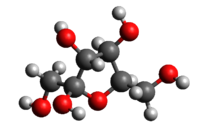Fructose metabolism
|
|||

Haworth projection of β-D-Fructofuranose
|
|||
 Ball-and-stick model of D-fructose
|
|||
| Names | |||
|---|---|---|---|
|
IUPAC name
(3R,4S)-1,3,4,5,6-Pentahydroxy-2-hexanone
|
|||
| Other names
Fruit sugar, levulose,D-fructofuranose, D-fructose, D-arabino-hexulose
|
|||
| Identifiers | |||
|
57-48-7 |
|||
| 3D model (Jmol) | Interactive image | ||
| ChEBI |
CHEBI:28645 |
||
| ChEMBL |
ChEMBL604608 |
||
| ChemSpider |
388775 |
||
| ECHA InfoCard | 100.000.303 | ||
| EC Number | 200-333-3 | ||
| KEGG |
C02336 |
||
| PubChem | 5984 | ||
| UNII |
6YSS42VSEV |
||
|
|||
|
|||
| Properties | |||
| C6H12O6 | |||
| Molar mass | 180.16 g·mol−1 | ||
| Density | 1.694 g/cm3 | ||
| Melting point | 103 °C (217 °F; 376 K) | ||
| -102.60·10−6 cm3/mol | |||
| Pharmacology | |||
| V06DC02 (WHO) | |||
| Hazards | |||
| Lethal dose or concentration (LD, LC): | |||
|
LD50 (median dose)
|
15000 mg/kg (intravenous, rabbit) | ||
|
Except where otherwise noted, data are given for materials in their standard state (at 25 °C [77 °F], 100 kPa).
|
|||
|
|
|||
| Infobox references | |||
| Nutritional value per 100 g (3.5 oz) | |
|---|---|
| Energy | 368 kcal (1,540 kJ) |
|
100 g
|
|
|
0 g
|
|
|
0 g
|
|
| Minerals | |
| Calcium |
(0%)
0 mg |
| Iron |
(1%)
0.1 mg |
| Phosphorus |
(0%)
0 mg |
| Potassium |
(0%)
0 mg |
| Sodium |
(1%)
12 mg |
|
|
|
|
|
| Percentages are roughly approximated using US recommendations for adults. Source: USDA Nutrient Database |
|
Fructose, or fruit sugar, is a simple ketonic monosaccharide found in many plants, where it is often bonded to glucose to form the disaccharide sucrose. It is one of the three dietary monosaccharides, along with glucose and galactose, that are absorbed directly into the bloodstream during digestion. Fructose was discovered by French chemist Augustin-Pierre Dubrunfaut in 1847. The name "fructose" was coined in 1857 by the English chemist William Miller. Pure, dry fructose is a very sweet, white, odorless, crystalline solid and is the most water-soluble of all the sugars. Fructose is found in honey, tree and vine fruits, flowers, berries, and most root vegetables.
Commercially, fructose is frequently derived from sugar cane, sugar beets, and corn. Crystalline fructose is the monosaccharide, dried, ground, and of high purity. High fructose corn syrup (HFCS) is a mixture of glucose and fructose as monosaccharides. Sucrose is a compound with one molecule of glucose covalently linked to one molecule of fructose. All forms of fructose, including fruits and juices, are commonly added to foods and drinks for palatability and taste enhancement, and for browning of some foods, such as baked goods.
About 240,000 tonnes of crystalline fructose are produced annually.
There is research indicating that excessive fructose consumption is a cause of insulin resistance, obesity, elevated LDL cholesterol and triglycerides, leading to metabolic syndrome,type 2 diabetes and cardiovascular disease. However, the European Food Safety Authority stated that fructose may be preferred over sucrose and glucose in sugar-sweetened foods and beverages because of its lower effect on postprandial blood sugar levels, but also noted that "high intakes of fructose may lead to metabolic complications such as dyslipidaemia, insulin resistance and increased visceral adiposity". Further, the UK's Scientific Advisory Committee on Nutrition in 2015 disputed the claims of fructose causing metabolic disorders, stating that "there is insufficient evidence to demonstrate that fructose intake ... leads to adverse health outcomes independent of any effects related to its presence as a component of total and free sugars."
...
Wikipedia


